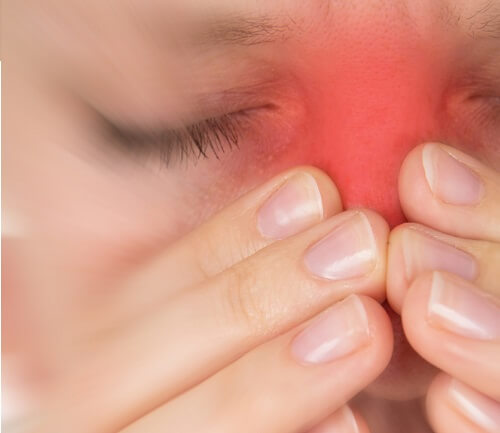Paranasal Sinuses: 5 Things You Should Know


Written and verified by psychologist Valeria Sabater
The paranasal sinuses are cavities full of air located in the bones of the skull. They have many functions: they help breathing, smell, and even the regulation of body temperature.
It’s often the case that we hardly ever notice certain parts of our body until a problem, illness, or change occurs.
Anyone who has suffered sinusitis, for example, will undoubtedly know exactly where their sinuses are.
These structures produce a type of liquid in order to contain, and protect us from, certain bacteria. What often happens is that the excess of mucus ends up clogging the cavities and causing inflammation.
It’s a common and annoying situation suffered by millions of people, and is one of many medical conditions that affect these delicate and curious structures of our anatomy. Today we’re going to tell you more about them.
1. How many paranasal sinuses do you have?
We have a total of 8 paranasal sinuses, 4 on each side of the nose. Let’s look at some interesting facts about them.
Maxillary sinuses
- The maxillary sinus is the largest of all paranasal sinuses
- It has a pyramid shape and an approximate capacity of 15 ml
- When we’re born, it’s very small, and it’s not until 8 or 9 years of age when it widens and descends from the top of the nose to the bottom
Frontal sinuses
- They measure about 3 cm by 2.5 cm and they’re two cavities separated by the interfrontal septum
- They’re connected to the trigeminal nerve and because of that it’s one of the most painful when inflamed
Ethmoid sinuses
This sinus is actually a set of ethmoidal cells, like small labyrinths which form next to the lacrimal bones.
Sphenoid sinuses
- These sinuses are fully formed when we turn 14 or 15 years old
- They have a capacity of about 7.5 ml
2. What’s inside the sinuses?

At the beginning of the article we said that there is only air inside these cavities.
In healthy and non-inflamed paranasal sinuses there will be mostly air. However, these areas are not completely empty.
- The nasal and paranasal sinuses are lined by a type of respiratory mucus
- This mucus is formed by a type of epithelium
- It’s a very thin layer of mucous cells that are attached to the bone or adjacent cartilage
- It serves many purposes: it aims to humidify and heat air heating before it enters the inside of the body
In turn, these cells also produce mucus to protect us from possible bacteria and foreign elements, and stop them from entering the body.
See also: 10 Tips to Get Rid of Excessive Mucus
3. Why do the paranasal sinuses get inflamed?
When we catch a cold or when we have allergies there’s an excessive growth of bacteria and germs in the paranasal cavity, which produces a bacterial or viral infection.
Most infections of the paranasal sinuses are viral and disappear on their own in a short time. However, sometimes the infection intensifies, producing 3 types of problems:
Acute sinusitis
Acute sinusitis is a very common condition associated with the common cold.
If it’s caused by a virus, it’ll heal itself in a few days, but if it’s a bacterial infection, acute sinusitis could last up to four weeks.
Subacute sinusitis
In this case, the problem is more serious and much more annoying. It has a lot to do with allergies, and can last between two and three months.
It is usually accompanied by:
- Constant mucus
- Headaches
- Dizziness
- Sensitivity to light
Chronic sinusitis
Chronic sinusitis is very debilitating for the person who’s suffering from it. It can last more than 3 months and can often end up with a surgical intervention.
Read more: Sinusitis Symptoms: From Origin to Diagnosis

4. Why are there people more prone to sinus infections than others?
All of us, at any given time, can suffer a sinus infection. But there are certain medical conditions and risk factors that can increase this possibility.
Let’s have a look at them.
- Having a diverted nasal septum
- Having nasal polyps
- Working in an environment where there is unclean air
- Living in a city where there is excess pollution
- Living in a house where there is a lot of mold or damp
- Dental infections can lead to inflammation of the paranasal sinuses
- Also, beware of having a weak immune system
- If you smoke, it’s also common to suffer inflammation in these cavities
5. How can I fight a sinus infection?

If a paranasal inflammation lasts more than two weeks, it’s best to go to the doctor.
Once you have a good diagnosis and a specific medical and pharmacological treatment, there are some simple homemade remedies that will help.
These are some quick examples:
- Vaporization with salt water
- Infusions and vapor with eucalyptus
- Infusions and rosemary vapor
- Radish and chopped onion poultices
- Infusion of ginger and honey
Last but not least, naps and breaks will also help to strengthen your immune system so that it can cope with infection on its own.
All cited sources were thoroughly reviewed by our team to ensure their quality, reliability, currency, and validity. The bibliography of this article was considered reliable and of academic or scientific accuracy.
Rosenfeld, R. M., Piccirillo, J. F., Chandrasekhar, S. S., Brook, I., Ashok Kumar, K., Kramper, M., … Corrigan, M. D. (2015). Clinical practice guideline (update): adult sinusitis. Otolaryngology–Head and Neck Surgery : Official Journal of American Academy of Otolaryngology-Head and Neck Surgery. https://doi.org/10.1177/0194599815572097
Manor, Y., Mardinger, O., Bietlitum, I., Nashef, A., Nissan, J., & Chaushu, G. (2010). Late signs and symptoms of maxillary sinusitis after sinus augmentation. Oral Surgery, Oral Medicine, Oral Pathology, Oral Radiology and Endodontology. https://doi.org/10.1016/j.tripleo.2010.02.038
This text is provided for informational purposes only and does not replace consultation with a professional. If in doubt, consult your specialist.








